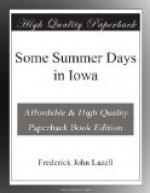September brings us the first and one of the most beautiful of the gentians, the white gentian. We are accustomed to think of the gentians as brilliantly blue, but the first one to adorn the waste places where the horses could not take the mower, is this white gentian. It is one of the plants which make a magnificent appearance in a tall, thin-stemmed vase, in your library. You need but one and if you chance to find a patch you may take a plant without any compunction of conscience, for they are usually numerous. At the top of the smooth stem are four leaves with heart-shaped bases, gradually tapering to points at the ends. These four pale green leaves cross each other after the manner of a St. Andrew’s Cross. Just where the four leaves are thus joined to the stem is a cluster of some six, eight, ten or even more, large, yellowish white, or greenish white blossoms. Perhaps at the next set of leaves, about four inches down the stem, there will be several other blossoms, in the axils. In the swamps and bogs the barrel-shaped blossoms of the closed gentians are growing larger day by day and by the twentieth of the month the fringed gentian, known only to a favored few, here in Iowa, will show the first of its blossoms.
* * * * *
In these last days of the summer there comes a grateful sense of the ripeness which crowns the year. Nothing in nature has hid its talent in a napkin. Every tree and shrub and herb has something to show in return for the privilege of having lived and worked in a world of beauty. Catbirds on the eve of their departure for the southland are feasting on the red and yellow wild plums, and the crab apples are beginning to give forth a faint fragrance which will grow more pronounced from now until October. The amber clusters of the hop are poured in profusion over the reddening fruit of the hawthorn. Farther on is the brook Eschol where the purple grapes are hanging. The snowy clusters of the sweet elder, which were so beautiful in July and early August, have developed into ample clusters of juicy berries which bring memories of the wine that grandmother used to make. Flocks of robins are feeding greedily on the abundant wild cherries. Thickets of panicled dogwood are feeding stations for other migrants; already the crimson fruit-stalks have been stripped of half their white berries. These native fruits are so many and so varied, they make the walk a constant delight. Each plant is a revelation. Who ever saw for the first time the huge clusters of fruit hanging from the wild spikenard on the face of the cliff and did not thrill with the charm of a great discovery? Each cluster of ruby, winey berries is as large as a hickory-nut and the clusters are aggregated upon stalks so as to resemble huge bunches of grapes. For contrast there are the little bunches of whitish berries on the low-growing false spikenard; they are speckled with reddish and gray dots as if they might be cowbird’s eggs in miniature.




